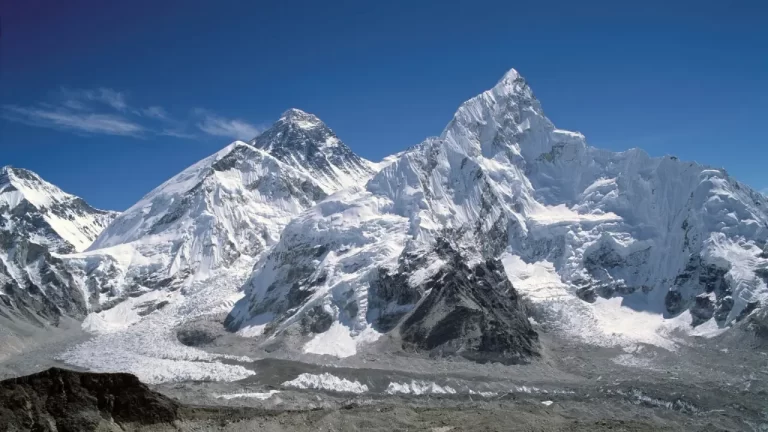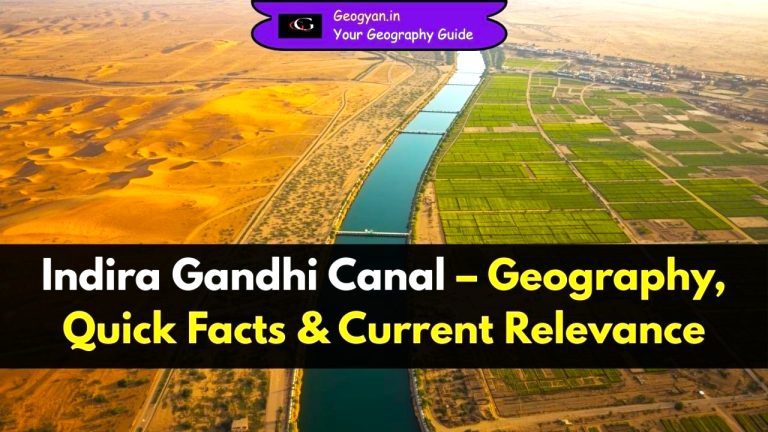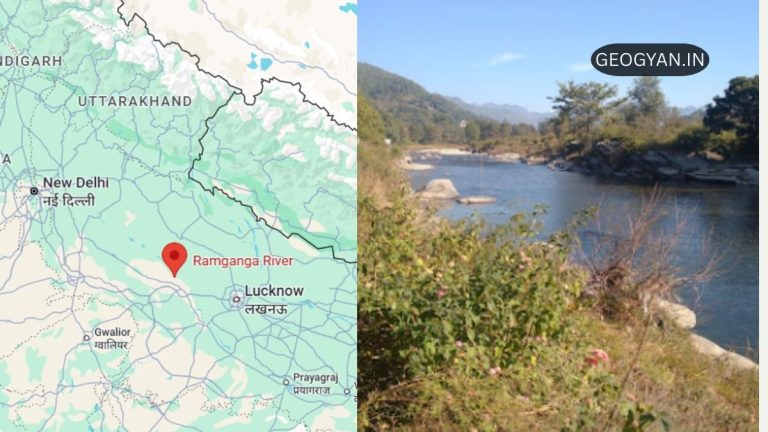Note: The following classification of Indian soils is according to the All-India Land Use and Soil Survey Organization established in 1953 by the Indian Council of Agricultural Research (ICAR).
Soil is formed under a specific natural environment and each of the elements of the environment plays an important role in this process, which known as the process of pedogenesis.
Soil is composed of particles of broken rocks reformed by chemical and physical processes which include weathering and erosion. Soils have different characteristics from its parent rocks due to the interactions between the lithosphere, hydrosphere, atmosphere, and biosphere. Soil is a mixture of minerals and organic matters that are in solid, gaseous, and aqueous form.
Soil types depend on ĵ rock structure, relief, slope, climate, and natural vegetation. Diversity of these factors led to the development of different types of soils in India.
The soils of India are classified based on four properties namely Genesis, colour, composition, and location.
Alluvial Soil
Formation
- Also known as ‘Kachhari Soil’.
- Formed by the deposition of eroded materials carried by the rivers.
Area
- Found in river basins, deltaic regions, and floodplains.
- The vast plains of northern India made up of these soils and found in the deltaic parts of rivers like Mahanadi, Godavari, Krishna, and Kaveri etc. that is why they also called deltaic soils.
- Apart from this, found in the Assam valley, Gujarat, and the western and eastern coastal plains.
- Spread over an area of 14.25 lakh square km and cover about 43.4 per cent of the total area of the country.
Characteristics
- Light brown and yellow.
- These are loamy in most places and sandy and smooth in other places.
- Depth of alluvial soils differs from one region to the other. Their maximum depth found below 600 meters in the Gangetic plain.
- Lacking in nitrogen, phosphorus, and vegetable content (humus), but potash and lime found in abundance. Therefore, these are extremely fertile.
- It is easier and less expensive to dig wells, tube wells and canals in these soils. Therefore, irrigation facilities easily developed in the areas of alluvial soils.
- Intensive farming is done in the area of alluvial soils.
- Major crops grown in these soils are rice, wheat, sugarcane, cotton, oilseeds, pulses, tobacco, and green vegetables.
There are five sub-divisions of alluvial soils based on composition and fertility.
New alluvial or Khadar soils
- The lowland region made up of new alluvial soils near the riverbank called as Khadar.
- More fertile due to the laying of a new layer of alluvium every year.
- More moisture retentive because of high content of Silica.
- Also called as ‘Bet’ land.
Ancient alluvial or Bangar soils
- The high region formed from old alluvial deposits called as Bangar.
- Flood water does not reach here.
- Rich in calcium deposits i.e., pebbles.
- Also called as ‘Dhaya’.
Terai soils
- Spread over the Terai region to the south of Bhabhar in Uttar Pradesh.
- Rich in nitrogen, and organic matter, but lacking in phosphate.
Coastal alluvial soils
- Found in the coastal regions of India and formed by the deposition work of sea waves.
- River deposition also contribute in their formation.
- Most of the eastern coast and the northern part of the western coast (from the Gulf of Khambhat to Mumbai) made up of coastal alluvial soils.
Deltaic alluvial soils
- Newest alluvial soils found in the deltaic parts of the Ganges-Brahmaputra, Mahanadi, Godavari, Krishna, and Kaveri rivers.
- Cheeka is a major component in these marshy and salty soils.
- Rich in humus, potash, lime, magnesium, and phosphorus
- One of the most fertile soils in the world. Major crops grown in these soils are rice and jute.

Black Soils
Formation
These soils originated from the solidification of basic lava spread over large areas of the Deccan plateau during volcanic activity. Therefore, formed by weathering of the Deccan Trap.
Area
- Found in Maharashtra, Madhya Pradesh, Chhattisgarh, Andhra Pradesh, Telangana, Gujarat, and Tamil Nadu.
- Spread over an area of about 5 lakh sq. km.
- After alluvial soils, black soils occupy the largest area in the country.
Characteristics
- On the basis of colour there are three types of black soil: (1) Shallow black soils, (ii) Medium black soils and (iii) Deep black soils
- Permanent (in situ) soils formed in their own place.
- Rich in Lime, iron, magnesium, calcium, carbonate, aluminum, and potash (LIMCAP-Lime, Iron, Magnesium, Calcium Carbonate, Aluminum and Potash)
- Lacking in humus, phosphorus, and nitrogen.
- Due to the high concentration of iron, these are black.
- The particles in black soils are dense and fine, due to which it has a good capacity to hold moisture.
- Best for dry farming because of moisture retentive capacity.
- Clayey by nature.
- The major drawback of these soils is that cracks occur in its upper layer when it dries up in summer which helps in air circulation or aeration. These soils become sticky during the rainy season. In both cases, it becomes difficult to plough.
- Very useful to produce cotton. Therefore, they called as black cotton soils. Sometimes black soils called as Regur. Also known by the names Tropical Black Earth and Tropical Shernizam etc. These soils have also proved to be the best for sugarcane, tobacco, wheat, and oilseeds.
Red and Yellow Soils
Formation
- Formed due to the wear and tear of metamorphic rocks due to weathering.
- Permanent (in situ) soils formed at their place of origin.
Area
- Widespread in the outer regions of the peninsular plateau which includes parts of Tamil Nadu, Karnataka, Andhra Pradesh, Telangana Chhattisgarh, south-eastern Maharashtra, Odisha and Chota Nagpur plateau.
- Spread over an area of about 2 lakh square km.
Characteristics
- Red due to the presence of iron compounds.
- Sometimes yellow, brown, chocolatey, and black.
- Due to being hydrated, appears yellow.
- Iron, lime, and aluminum predominate but are deficient in nitrogen, phosphorus, and organic matters.
- Relatively less fertile and more suitable for dry farming.
- Using fertilizers, rice, wheat, sugarcane, cotton, and pulses grown.
Laterite Soils
Formation
The word Laterite in Latin means Brick. These red-colored soils, like ‘Brick’, formed under conditions of high rainfall and high temperature of monsoon climate. The alterations of the wet and dry seasons lead to the leaching away of siliceous matter and lime from the upper layer; iron and aluminum left on the top.
Area
- Found in the Western Ghats, Nagpur plateau, hilly areas of Tamil Nadu, Andhra Pradesh, Telangana, Odisha, Maharashtra, Madhya Pradesh, and Assam.
- Spread over an area of about 2.48 lakh sq. km.
Characteristics
- Acidic in nature
- Deficient in nitrogen, lime, phosphorus, magnesium, and organic matter,therefore less fertile.
- Red due to the presence of iron oxides.
- Stony and porous at some places.
- Although not suitable for agriculture, still considered favorable for pastures and bushy forests.
- Crops like coffee, rubber and cashew grown in these soils with the use of fertilizers.
- Used extensively for building construction.
Arid Soils
Also called as loamy or desert soils.
Formation
Sand formed because of physical weathering of rocks in dry and hot climate. These formed after the transportation and deposition of the sand by the wind.
Area
Found in dry areas with an average annual rainfall of less than 50 cm, especially in Rajasthan, North Gujarat, South-West Punjab, and Southern Haryana in a 1.42 lakh sq. km area.
Characteristics
- Mineral salts found in abundance.
- Lacking in water, natural vegetation, nitrogen, and organic matter.
- Alkaline in nature.
- Become fertile when irrigated and wheat, gram, jowar, millet, vegetables etc. can be grown. The Indira Gandhi Canal Project has proved, with a proper irrigation system, can grow thriving crops in the desert of Rajasthan.
- Ranges from red to raisin.
Forest and Mountain Soils
Formation
- Formed in forest areas with sufficient rainfall or in a mountainous environment.
- Formed by the mechanical (physical) weathering of rocks by snow, rain, and sequential changes in temperature.
- Most of the forest soils formed by weathering of rocks of Tertiary age.
Area
- Found in the forested areas of the mountainous parts of Jammu and Kashmir, Sikkim, Assam, Uttarakhand, and Arunachal Pradesh.
- Spread over an area of 2.85 lakh sq. km.
Characteristics
- Coarse soils, abundance of pebbles and rock fragments.
- Relatively large size of particles and absence of cheeka, So, cannot hold water. Therefore, suitable for tree crops or crops which require permeable soil.
- Rich in Iron content and organic matter and lacking in lime and potash.
- Tea, coffee, apple, peach, cherry, walnut, and medicinal plants grown on mountain slopes.
Saline and Alkaline Soils
Formation
- When the proportion of salts and bases in a particular soil becomes high, then such soil called as saline and alkaline soil.
- Formed on Ill drained areas prone to the problem of water logging.
- When evaporation occurs in areas of high groundwater levels and is irrigated by canals, salts come from the bottom to the surface by capillary action and make the soil infertile.
- Due to the accumulation of tidal water in the coastal areas, coastal soils also become saline.
Area
- Found in dry regions, especially in western Rajasthan, northern Gujarat, southern Punjab, southern Haryana, and western Uttar Pradesh.
- Found around the Gulf of Khambhat in Gujarat due to the accumulation of salty water in the sea.
- Spread over an area of 68,000 sq. km
Characteristics
- Known by many names like Thur, Usar, Reh, Kallar, Shankar and Chopan etc.
- Infertile but cultivated using organic fertilizers.
- Utilize in the cultivation of crops like rice, wheat, cotton, sugarcane, tobacco etc.
Peaty and marshy
Formation
Formed due to the constant presence of water in areas of high humidity or coastal areas.
Area
Found in the Sunder-Van region of West Bengal, the coastal areas of Orissa, Andhra Pradesh and Tamil Nadu and the Terai belt of Uttar Pradesh.
Characteristics
- The amount of iron and fauna is found to be very high.
- Useful for the cultivation of jute.
- Most of the peat soils submerged in water during the rainy season.
- Rice sown after the rainy season.
- Peaty soils found in Kerala, where called as Kari.
- Found in the western parts of the Kottayam district and parts (peaty) of the Alappuzha district of Kerala.
- Black and highly acidic.





























